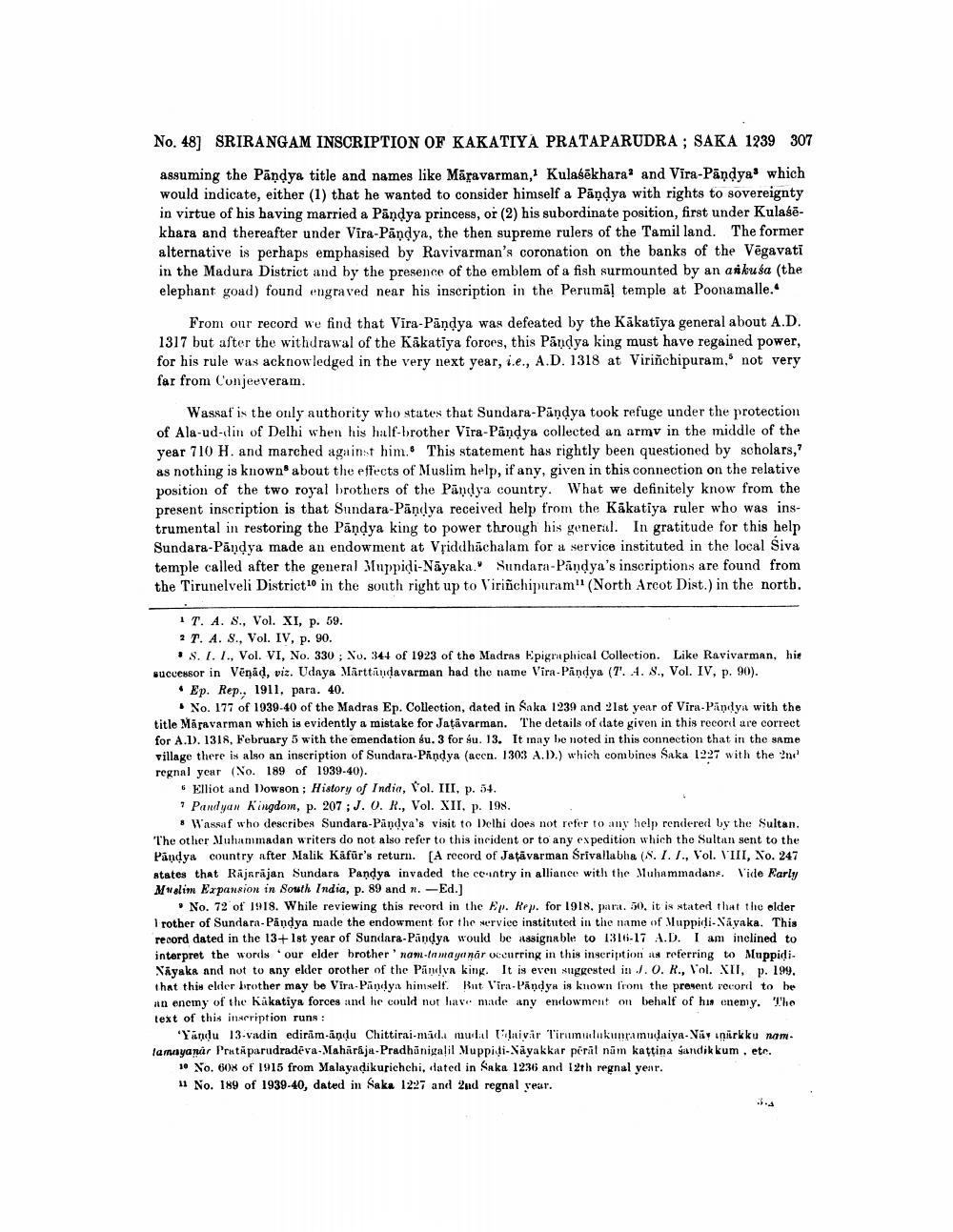________________
No. 48] SRIRANGAM INSCRIPTION OF KAKATIYA PRATAPARUDRA; SAKA 1239 307
assuming the Pandya title and names like Märavarman, Kulasēkhara and Vira-Pandya' which would indicate, either (1) that he wanted to consider himself a Pāņdya with rights to sovereignty in virtue of his having married a Pandya princess, or (2) his subordinate position, first under Kulasekhara and thereafter under Vira-Pāņdya, the then supreme rulers of the Tamil land. The former alternative is perhaps emphasised by Ravivarman's coronation on the banks of the Vēgavati in the Madura District and by the presence of the emblem of a fish surmounted by an arku sa (the elephant goad) found engraved near his inscription in the Perumal temple at Poona malle.
From our record we find that Vira-Pāndya was defeated by the Kākatiya general about A.D. 1317 but after the withdrawal of the Kakatiya forces, this Pandya king must have regained power, for his rule was acknowledged in the very next year, i.e., A.D. 1318 at Virinchipuram, not very far from Conjeeveram.
Wassaf is the only authority who states that Sundara-Pandya took refuge under the protection of Ala-ud-din of Delhi when his half-brother Vira-Pandya collected an army in the middle of the year 710 H. and marched against him. This statement has rightly been questioned by scholars,? as nothing is known about the effects of Muslim help, if any, given in this connection on the relative position of the two royal brothers of the Pandya country. What we definitely know from the present inscription is that Sundara-Pandya received help from the Kakatiya ruler who was instrumental in restoring the Pandya king to power through his general. In gratitude for this help Sundara-Pandya made an endowment at Vșiddhachalam for a service instituted in the local Siva temple called after the general Muppidi-Nāyaka.Sundara-Pandya's inscriptions are found from the Tirunelveli District 10 in the south right up to Viriñchipuram" (North Arcot Dist.) in the north.
IT. A. S., Vol. XI, p. 59. ?T. A. S., Vol. IV, p. 90.
S.I.I., Vol. VI, No. 330 ; No. 344 of 1923 of the Madras Epigraphical Collection. Like Ravivarman, hie successor in Vēnād, viz. Udaya Märttindavarman had the name Vira-Pandya (7. 4. S., Vol. IV, p. 90).
• Ep. Rep., 1911, para. 40.
Xo. 177 of 1939-40 of the Madras Ep. Collection, dated in Saka 1239 and 21st year of Vira-Pandya with the title Maravarman which is evidently a mistake for Jaţāvarman. The details of date given in this record are correct for A.1). 1318, February 5 with the emendation su. 3 for su. 13. It may be noted in this connection that in the same village there is also an inscription of Sundara-Pandya (acen. 1303 A.D.) which combines Saka 1227 with the ne regnal year (No. 189 of 1939-40).
• Elliot and Dowson ; History of India, Vol. III, p. 54. ? Pandyan Kingdom, p. 207; J. 0. R., Vol. XII, p. 198.
# Wassaf who describes Sundara-Pandya's visit to Delhi does not refer to any help rendered by the Sultan. The other Muhammadan writers do not also refer to this incident or to any expedition which the Sultan sent to the Pandya country after Malik Kafür's return. (A record of Jatavarman Srivallabha ( L I., Vol. VIII, No. 247 atates that Räjarājan Sundara Pandya invaded the country in alliance with the Muhammadans. Vide Karly Mwalim Expansion in South India, p. 89 and n. -Ed.]
No. 72 of 1918. While reviewing this record in the Ep. Rep. for 1918, parat. .50, it is stated that the older Irother of Sundara-Pandya made the endowment for the service instituted in the name of Muppidi-Xayaka. This record dated in the 13+ 1st year of Sundara-Pandya would be assignable to 1316-17 A.D. I am inclined to interpret the words our elder brother nam-tama yanår occurring in this inscription is referring to Muppidi. NĀyaka and not to any elder orother of the Pandiva king. It is even suggested in J.0. R., Vol. XII, p. 199. that this elder brother may be Vira-Pandya himself. But Vira-Pandya is known from the present record to be an enemy of the Kakatiya forces and he could not have made any endlowment on behalf of his enemy. The text of this inscription runs :
'Yundu 13-vadin ediram-andu Chittirai-mad. mulalaivar Tirumulakumramudaiya-Nay inirkku nam. lamayanar Prutāparudradeva Mahārāja-Pradhūnigalil Muppidi-Nayakkar peral nām kattina yandikkum, etc.
10 No. 60% of 1915 from Malayadikurichchi, cated in Saka 1236 and 12th regnal year. 11 No. 189 of 1939-40, dated in Saka 1227 and 2nd regnal year.




